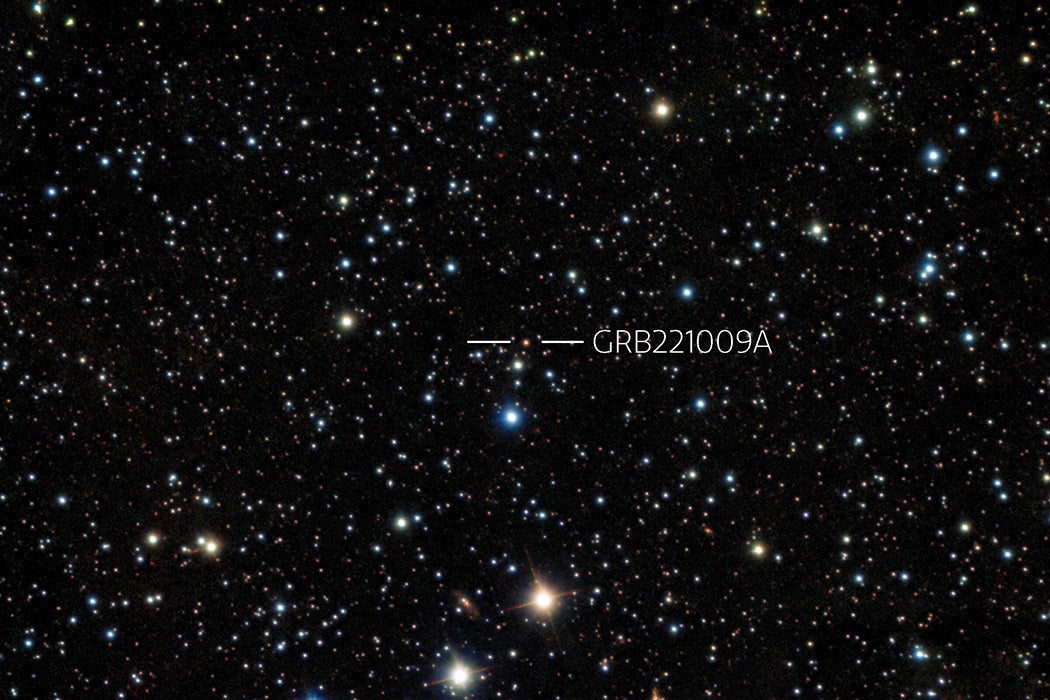On October 9, 2022, radiation detectors on orbiting astronomical observatories registered an enormous spike of energy. They were under an intense barrage of gamma rays aimed at Earth—rays originating from somewhere deep in space. The blast was not caused by an extraterrestrial super-weapon. Instead, its cause was the most powerful explosion observed anywhere in the Universe. A recent paper published in Science Advances provides details of what caused the blast.
GRB 221009A
The event in question is called GRB 221009A. GRB stands for gamma-ray burst, an event that occurs when a massive star collapses and becomes a black hole. Under the right conditions, the collapse generates very powerful magnetic fields, directing some of the collapsing material toward the poles of the star and shooting that material out as two jets traveling near the speed of light. These jets are unbelievably bright, and they can be detected billions of light-years away.
The energy released in these jets is immense. If a gamma-ray burst occurred within 100 light-years of Earth and its jet was pointed at us, it would vaporize our planet. At greater distances that are still small on astronomical scales, the blast would sterilize the side of the planet that the jet hit.
GRB 221009A was caused by the collapse of a star in a galaxy 2.4 billion light-years away—relatively close as cosmic distances go. When taking distance into account, this GRB was found to be the brightest one ever observed, ten times brighter than the previous record holder. Astronomers have started calling it the BOAT—the Brightest Of All Time. Astronomers could not explain why this particular blast was so bright, but the paper in Science Advances proposes an explanation.
Extended Release
On October 8 at 13:16:59 UT, orbiting satellites detected an initial blast of gamma rays that lasted for hundreds of seconds. The gamma-ray burst happened very far away, yet it deposited energy equivalent to exploding a ton and a half of TNT into the Earth’s atmosphere. The energy was enough to disturb the Earth’s ionosphere over Northern Europe, and the highest-energy gamma rays from the event were more intense than the collision energy of the Large Hadron Collider, the Earth’s most powerful particle accelerator.
The energy released in GRBs comes in two phases. The first intense burst of gamma rays is followed by a longer, slower emission across a broad spectrum of electromagnetic energy—from low-energy radio waves to visible light, X-rays, and extremely high-energy gamma rays. This slower component of the energy emission from the GRB is especially mysterious.
The initial blast of gamma rays in a GRB comes from the star’s collapse, while the slower event comes from the interaction of those gamma rays with material surrounding the collapse. Gamma rays heat up this material, giving rise to the secondary emission.
For most GRBs, the secondary emission fades slowly for a short while, then changes its behavior and dissipates quickly. But this gamma-ray burst was different. Its secondary emission persisted for much longer than hours or a small number of days, as is typical. Depending on the wavelength, some of the electromagnetic radiation persisted for a month or more. (Because GRB 221009A was located in the plane of the Milky Way, dust obscured much of the visible light from the GRB. However, X-ray and radio waves transmitted well.)
Weekly Newsletter
Scientists are not quite sure why the BOAT was so bright or why the secondary emission lasted so long. A perfect alignment of the jet with the Earth might account for both observations. But the paper by Brendan O’Connor and colleagues does not rely on serendipitous alignment. Instead, the authors propose that the first jet had difficulty escaping the surrounding material. The mixing of the jet with the material that surrounded it sustained the emission of light by constraining the jet and effectively focusing it. The jet was thus collimated by the interaction, which kept it from dispersing in the expected way.
This GRB Was a First-in-Civilization Event
GRB 221009A is fascinating both for its brightness and for its unusual secondary emission characteristics, but was it indeed the brightest of all time? Probably not. In the history of the universe, there have almost certainly been brighter gamma-ray bursts. However, when astronomers collate observations of numerous GRBs to calculate how often events like GRB 221009A occur, researchers estimate that they can be expected to be observed on Earth perhaps as often as once every 1,000 years, or as seldom as once every 10,000 years.
GRB 221009A, then, might be the brightest GRB to occur for all of human civilization—and certainly for as long as humans have turned telescopes to the sky. It was a singular event, one that researchers do not expect to see repeated during our lifetimes. And when we understand better the mechanisms that made it happen, the Universe will be a little less mysterious.
Support JSTOR Daily! Join our membership program on Patreon today.







